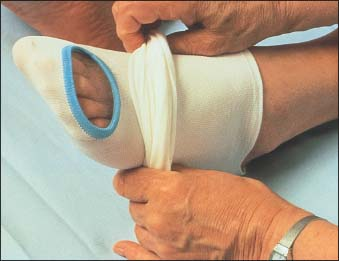Antiembolism Stocking Application
Elastic antiembolism stockings help prevent deep vein thrombosis (DVT) and pulmonary embolism by compressing superficial leg veins. This compression increases venous return by forcing blood into the deep venous system rather than allowing it to pool in the legs and form clots. Antiembolism stockings can provide equal pressure over the entire leg or a graded pressure that’s greatest at the ankle and decreases over the length of the leg. Usually indicated for postoperative, bedridden, elderly, or other patients at risk for DVT, these stockings shouldn’t be used on patients with dermatoses or open skin lesions, gangrene, severe arteriosclerosis or other ischemic vascular diseases, pulmonary or any massive edema, recent vein ligation, or vascular or skin grafts. For patients with chronic venous problems, intermittent pneumatic compression stockings may be ordered during surgery and postoperatively. (See “sequential compression therapy,” page 645.)
Equipment
Tape measure ▪ antiembolism stockings of correct size and length ▪ talcum powder.
Preparation of Equipment
Before Applying A Knee-Length Stocking
Measure the circumference of the patient’s calf at its widest point and leg length from the bottom of the heel to the back of the knee. (See Measuring for antiembolism stockings.)
Before Applying A Thigh-Length Stocking
Measure the circumference of the calf and thigh at their widest points and the leg length from the bottom of the heel to the gluteal fold.
Before Applying A Waist-Length Stocking
Measure the circumference of the calf and thigh at their widest points and the leg length from the bottom of the heel along the side to the waist.
Obtain the correct size stocking according to the manufacturer’s specifications. If the patient’s measurements are outside the range indicated by the manufacturer or if his legs are deformed or edematous, ask the doctor if he wants to order custom-made stockings.
Implementation
Check the doctor’s order.
Confirm the patient’s identity using at least two patient identifiers according to your facility’s policy.1
Provide privacy and explain the procedure to the patient.
Assess the patient’s condition. If his legs are cold or cyanotic, notify the doctor before proceeding.
Have the patient lie down. Then dust his ankle with talcum powder to ease application.
Applying A Knee-Length Stocking
Insert your hand into the stocking from the top and grasp the heel pocket from the inside. Holding the heel, turn the stocking inside out so that the foot is inside the stocking leg. This method allows easier application than gathering the entire stocking and working it up over the foot and ankle.
With the heel pocket down, hook the index and middle fingers of both your hands into the foot section. Facing the patient, ease the stocking over the toes, stretching it sideways as you move it up the foot.
Support the patient’s ankle with one hand and use the other hand to pull the heel pocket under the heel. Then center the heel in the pocket.
Gather the loose portion of the stocking at the toe and pull only this section over the heel (as shown below).
 |
Measuring for Antiembolism Stockings
Stay updated, free articles. Join our Telegram channel

Full access? Get Clinical Tree


Get Clinical Tree app for offline access
